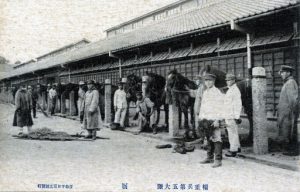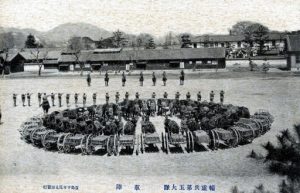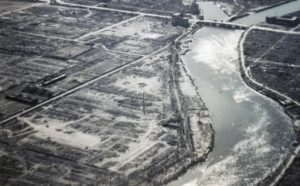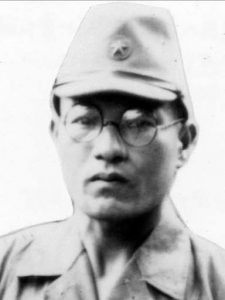Striving to fill voids in Hiroshima — “Shichotai” military base A-bombed remnants discovered at planned site of new soccer stadium
Jun. 15, 2021
Photos and notes convey horror of base as it becomes engulfed in sea of flames
by Kyosuke Mizukawa, Staff Writer
Large-scale A-bombed remnants of the Chugoku District transport soldier recruitment unit, known as “Shichotai” in Japanese, have been discovered in the open space of Hiroshima’s Central Park, located in the city’s Naka Ward. At least ten photographs remain of Shichotai depicting the unit’s barracks and soldiers before its destruction in the atomic bombing. Photos and Shichotai soldiers’ personal notes that convey the horrific circumstances after the bombing have also been preserved. The surviving families of the soldiers are hoping that excavation of the artifacts in the park will heighten awareness of the war and the A-bombing atrocity that are etched into the site where a new soccer stadium in Hiroshima is scheduled for construction.
In its search for materials related to Shichotai, the Chugoku Shimbun has found archived photos taken before the atomic bombing that were collected by citizens and also stored at the Hiroshima Municipal Archives, located in the city’s Naka Ward. Most of the photos were taken from the late Taisho period (1912–1926) to the beginning years of the Showa era (1926–1989), during the days when Shichotai was known by the unit’s former name of Transport soldier troop No. 5. The photos show stables designed for the rearing of horses used in battle, training related to the circling of horse carriages, and motorized troop exercises, which formed the daily operations carried out by Shichotai, a unit engaged in battlefield transport work.
“When I went to see my father there, he let me drink something like juice. I also remember there were lots of horses,” said Akito Suwa, 87, a resident of Hiroshima’s Naka Ward. When a boy, Mr. Suwa used to visit Shichotai’s barracks because his father Noboru, who had previously worked in the lumber industry and died in 2002 at the age of 96, had been drafted into the military and joined the unit.
Soldiers in Shichotai were dispatched to various fields of battle. Noboru was sent to mainland China. The unit’s motorized unit of about 150 soldiers operated in the Philippines, although more than 90 percent of the force died there in fighting or from malaria. As the war situation worsened and Japan continued to fight and to recruit soldiers, August 6, 1945 happened.
No remains were found
After the war concluded, Noboru Suwa and others compiled a book titled Hiroshima Shicho Heitai Shi (History of Hiroshima Transport Soldiers, in English), which includes a description of the atomic bombing experience written by a former Shichotai soldier. “Everything in the barracks was on fire. Everywhere I heard the intolerable screams of the dying calling out for help and crying out in pain.”
Muneso Okifuji, 87, a resident of the town of Akiota-cho in Hiroshima Prefecture, said, “My father’s remains have yet to be found.” When Mr. Okifuji was 11, he lost his father Masato, then 37, who had been recruited into the military and assigned to Shichotai. On August 6, Muneso was scheduled to visit his father with his mother, taking with them mochi (rice cakes) and sushi, based on information they had received that Masato might be sent overseas.
After the end of the war, Mr. Okifuji and his wife Katsuko, 82, went to the site where Shichotai had been based, removed soil near the river, and placed it into their family grave in the place of his father’s remains. Looking at photos of the Shichotai artifacts, Mr. Okifuji and his wife said, “We believe he still sleeps under the site of the unit. What we wish most is to find his remains, but we are very moved to be able to see any remnants of the unit at all.”
Shichotai site paid attention as part of Hiroshima’s restoration history
The poem titled “To a Lady,” written by the poet Sankichi Toge, describes rows of shacks built on the former Shichotai site and stone pavement relics that were used as a watering place for horses. The poem is included in Genbaku Shishu (Poems of the Bomb, in English), a collection of poems written by Mr. Toge and published in 1951. The excavation conducted by the city has uncovered A-bombed remnants that appear to be that very stone pavement. The site appears as if it will attract attention from the perspectives of both Hiroshima’s reconstruction history and A-bomb literature.
Shunsuke Taga, 71, a resident of Hiroshima’s Nishi Ward, argued the importance of the excavation in the city’s Central Park. “It’s a place where various aspects of Hiroshima’s history are preserved, including the city as a military hub, the atomic bombing, and post-war restoration.” Mr. Taga is a member of a citizens group that promotes utilization of A-bombed artifacts in Hiroshima Peace Memorial Park. He added, “I have been very concerned about the site since the city government chose not to hold any briefings about it for a long time. I hope the city can share information proactively with the public about the valuable remnants on the site, while at the same time taking appropriate measures against the coronavirus.”
(Originally published on June 15, 2021)











